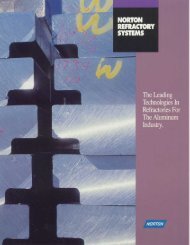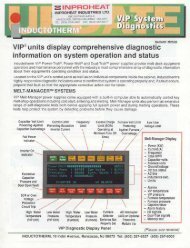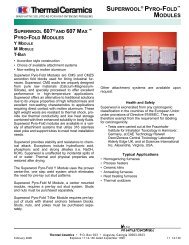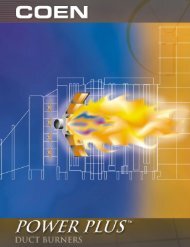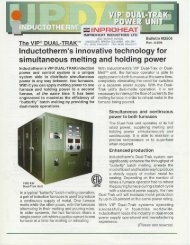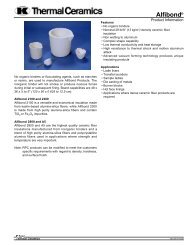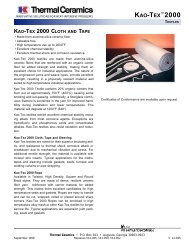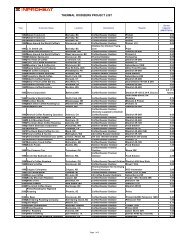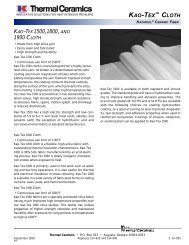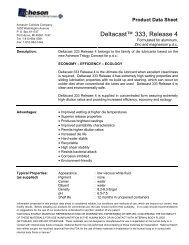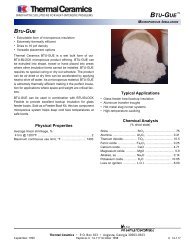Coen Development of a High Performance Versatile Low ... - Inproheat
Coen Development of a High Performance Versatile Low ... - Inproheat
Coen Development of a High Performance Versatile Low ... - Inproheat
Create successful ePaper yourself
Turn your PDF publications into a flip-book with our unique Google optimized e-Paper software.
5. An attempt was made to reach minimum possible NOx emissions in this 100,000 pph “A”type packaged boiler (Vernon, CA) by applying QLN and FGR. The unit was originally setto 15 ppm NOx with 25% FGR. Later on in order to control CO emissions the burner wasreset to 22% FGR and 19 ppm NOx. The necessity <strong>of</strong> this reset was caused by deterioration<strong>of</strong> patchwork sealing gaps in the water tube walls <strong>of</strong> this old boiler and resulting increase inCO. This was the only job where a combination <strong>of</strong> bulk mixed and selective FGR wasapplied.6. Retr<strong>of</strong>it <strong>of</strong> a 4 burner boiler, firing Natural Gas with the total maximum firing rate <strong>of</strong> 320MMBtu/Hr (Orange, Texas). The application is also interesting by high combustion airtemperature <strong>of</strong> 630 deg F. The boiler was outfitted with QLN/H burners - a modification <strong>of</strong>QLN designed to accommodate for smaller size openings in the boiler front wall. Theachieved NOx emissions were 110 ppm without FGR. CO emissions were insignificant. Iflarger openings for the burners would be available, NOx emissions could <strong>of</strong> been reduced byan additional 15%.7. Retr<strong>of</strong>it <strong>of</strong> a 250,000 pph boiler firing Refinery Gas. Four QLN burners were furnished forthis boiler in Texas. The achieved NOx emissions were 58 ppm without FGR. COemissions were insignificant. The refinery gas adiabatic flame temperature was 120 deg Fhigher than <strong>of</strong> Natural Gas. This caused an estimated NOx increased by about 50%.Another specific <strong>of</strong> this application is that the Refinery Gas contained some liquids, so thedesign <strong>of</strong> the burner was changed to provide for the maintenance convenience.8. Retr<strong>of</strong>it <strong>of</strong> a 150,000 pph B&W packaged boiler with a single QLN firing up to 185MMbtu/Hr,Huron, Ca. As noted earlier, NOx emissions with QLN burners are higher in high spaceheat release furnaces. Actually for packaged boilers with steam production over 100,000 pphthe main parameter that determines NOx with a given amount <strong>of</strong> FGR is the heat release perthe unit <strong>of</strong> furnace cross section. This 150,000 pph was equipped with the maximum sizeQLN burner. The achieved emissions were 70 ppm NOx without FGR. It hardly be matchedwith any other existing equipment. To meet 30 ppm NOx 10% FGR was required.Conventional burners would require 15-18% to meet 30 ppm NOx.9. Oil Firing With QLN burners. A special type <strong>of</strong> oil cap drilling was designed for firing #2 oiland #6 oil with QLN burners. Coupled with <strong>Coen</strong> MV type oil atomizers QLN burners weretypically showing NOx ranging from 75 to 90 ppm when firing in packaged boilers withoutusing the FGR. This is about 20-30% less than with the conventional burners. Statisticaldata firing #6 oil with QLN are still insufficient to claim any significant NOx reduction.7





